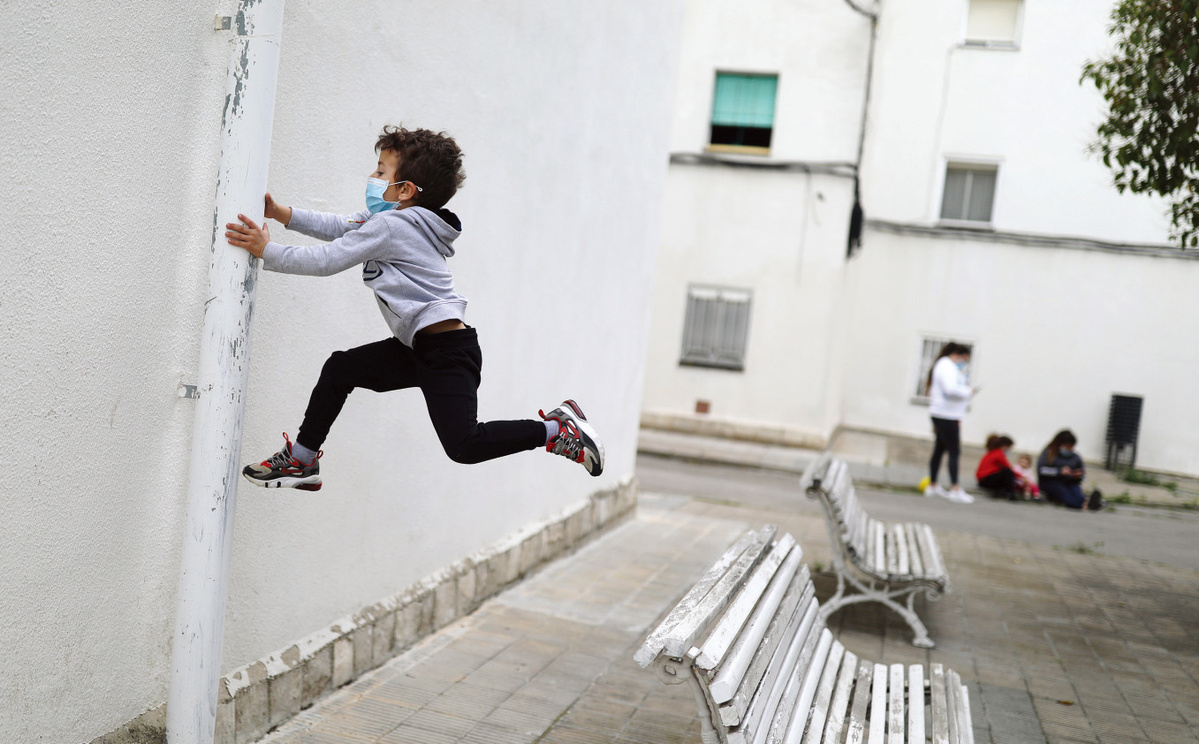美媒解读第二波疫情风险:从哪来?怎么防? Why a Second Wave of Covid-19 Is Already a Worry
彭博社、参考消息网 2020-04-28 15:38

新冠肺炎疫情是否会在晚些时候迎来第二波?人类又该如何阻止其暴发?美国媒体最近针对这些人们关心的问题进行了解读。

Kilian, 6, wears a protective face mask as he jumps from a bench in Igualada, Spain on Sunday, after restrictions on children going outside during the novel coronavirus outbreak were partially lifted. [NACHO DOCE/REUTERS]
As authorities the world over consider when to lift economy-crippling movement restrictions aimed at curbing coronavirus infections, the fear on everyone’s minds can be expressed in two words: second wave. The concern is that, once quelled, the pandemic will resurface with renewed strength, causing a repeat of rising infections, swamped health systems and the necessity of lockdowns.
旨在遏制新冠病毒感染的出行限制措施对经济造成了损害。当世界各地政府考虑何时取消这些限制措施时,每个人心中的恐惧可以用三个字表达:第二波。大家担心的是,暂时平息之后,疫情将以新的强度卷土重来,再次导致感染病例增加、卫生系统瘫痪以及必须实施封锁。
quell [kwel]: vt.平息;镇压;减轻;消除
1.What’s a second wave?
什么是第二波?
Pandemics are caused by new pathogens that the vast majority of humans have no immune protection against. That’s what allows them to become global outbreaks. Pandemics are uncommon, but influenza is one of the more frequent causes.
全球大流行病是绝大多数人类不具备免疫防护的新病原体引起的。这使得它们能席卷全球。全球大规模暴发的疫情并不常有,流感是引发流行病较常见的原因之一。
What often happens is that a novel variant of flu virus spreads around the world and then recedes, kind of like a tsunami. A few months later, it comes back and spreads around the world, or large parts of it, again.
经常发生的情况是,流感病毒的新变异株在世界各地扩散,然后消退,有点像海啸。几个月后,它卷土重来,再次在世界各地或大部分地区扩散。
2.What makes the first wave recede?
是什么让第一波疫情消退?
Influenza pandemics can be temporarily beaten back by the change of seasons, moving to the southern hemisphere when the northern half of the globe heats up during its summer, and vice versa. The virus may also have infected a huge portion of people in most areas, giving them immunity from re-infection and possibly creating so-called herd immunity, which protects those who haven’t been infected by curtailing the virus’s circulation.
流感大流行可能会被季节变化暂时击退,在北半球夏季升温时转移到南半球,然后再反过来。这种病毒还可能在大多数地区感染大量人口,使他们形成免疫,不会再次感染,可能会形成所谓的群体免疫,由此减少病毒传播来保护尚未感染的人。
In the case of the coronavirus that causes Covid-19, countries around the world have adopted movement restrictions on an unprecedented scale and social-distancing measures that together keep people far enough apart so that the virus can’t easily spread.
就新冠病毒而言,世界各国都以前所未有的规模采取了行动限制和保持社交距离的措施——这些措施使人们保持足够远的距离,让病毒无法轻易传播。
3.So how does a virus come back?
病毒如何卷土重来?
There are a number of possibilities. In the case of influenza, there’s the onset of cool weather, a factor that may affect the coronavirus, too. Or the pathogen can mutate. This is another feature of flu, which mutates more or less constantly.
有几种可能性。就流感而言,天气会转凉,这个因素也可能会影响新冠病毒。或者病原体可能会变异。这是流感的另一个特点,基本在不断变异。
In the fall of 1918, a second wave of the historic influenza outbreak occurred and caused most of the deaths in the pandemic. Some researchers believe it was brought about by a mutation that made the virus again unrecognizable to most people’s immune systems. Another important variable is the movement of the virus to populations that haven’t been exposed before and don’t have immunity.
1918年秋天,历史上著名的流感疫情出现第二波暴发,造成了那次大流行中的大多数死亡。有些研究人员认为,那是变异造成的,变异导致大多数人的免疫系统无法识别这种病毒。另一个重要的变化因素是病毒向以前没有接触过它、所以不具备免疫力的人群传播。
In addition, the World Health Organization said on April 24 that there’s no evidence yet that people who have recovered from Covid-19 and have antibodies are protected from a second infection.
另外,世界卫生组织于4月24日表示,尚无证据表明感染新冠病毒康复且带抗体者不会二次感染。

People walk by a billboard at Harlem's Apollo theater stating "Be Well" on April 24, 2020, in New York City. [Photo/Agencies]
4.Why wasn’t there a second wave of SARS?
为什么没有出现第二波非典?
The 2002-2003 outbreak of severe acute respiratory syndrome in Asia never reached the scope of a pandemic. Though caused by a coronavirus, it wasn’t as contagious as the one responsible for Covid-19. Its spread was mainly restricted to hospitals and other settings where people came in close contact with the body fluids of infected patients.
亚洲2002年至2003年暴发的非典疫情从未达到大流行的规模。尽管它是由冠状病毒引起的,但传染性不像新冠病毒那么强。其传播主要限于人们与受感染患者的体液密切接触的医院和其他场所。
Ebola is another pathogen relatively new to humans. There have been periodic outbreaks in Africa, but while the virus is highly contagious in some settings, it hasn’t been sufficiently infectious to spread around the world like the coronavirus.
埃博拉是另一种对人类来说相对较新的病原体。非洲定期暴发埃博拉疫情,但是,尽管这种病毒在某些地方具有高度感染性,但其感染性不足以像新冠病毒那样在全世界扩散。
5.What are the prospects for second waves of coronavirus?
发生第二波新冠疫情的可能性有多大?
There have been hints that a second wave is a risk. Some areas that were shut down by the virus and then reopened had restrictions reimposed because of new cases. Much of the rest of the world is still struggling to get the current wave under control. Most areas that have contained the virus have done so using movement restrictions, which slow the virus’s spread but leave many people vulnerable to infection once they begin to venture out again, raising the prospect of second waves.
有迹象表明,可能会出现第二波疫情。由于出现新发病例,此前因新冠病毒而封锁、随后重新开放的一些地区再次实施了限制措施。其他许多国家仍在努力控制当前这波疫情。大多数已经控制住该病毒的地区采取了行动限制措施,它减缓了病毒传播,但使得许多人在恢复外出时容易受到感染,从而增大了暴发第二波疫情的可能性。
6.What could prevent them?
如何能阻止第二波疫情?
The WHO has recommended lifting movement restrictions in stages to test the effect of each before moving to greater openness. In any case, experts say, the key to keeping infections low without locking down everyone is to scale up testing and contact tracing. Health authorities need to find infected people, isolate them, and identify their recent contacts, so they can be tested as well and isolated if necessary. Eventually, it’s possible that enough people will become exposed to the coronavirus that herd immunity will develop and it will stop spreading, or that a vaccine against it will be licensed.
世界卫生组织建议分阶段取消行动限制,以检验每个阶段的效果,然后再进一步放开。专家说,无论哪种情况,在不对所有人实施封锁的情况下保持低感染率的关键是加大检测和追踪接触者的力度。卫生当局需要找出受感染者,将他们隔离,确认他们最近的接触者,以便对这些人进行检测并在必要时加以隔离。最终,有可能有足够多的人接触到病毒,从而形成群体免疫,病毒会停止传播,或者等到针对这种病毒的疫苗获得批准。
来源:彭博社、参考消息网
编辑:yaning

















 英语点津微信
英语点津微信 双语小程序
双语小程序